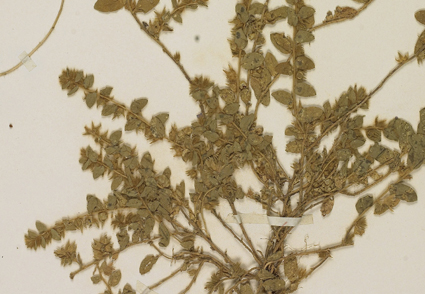Abstract
Evolvulus comprises approximately 100 American species and is one of the largest genera in Convolvulaceae; it includes taxa that are sometimes difficult to identify; some of them have typification and taxonomic problems. Both nomenclatural and taxonomic issues were detected during the ongoing taxonomic treatment of the Evolvulus species from the northeastern region of Brazil. This study was conducted with a comprehensive protologue analysis, study of herborized specimens, including types, observation of populations in the field, and morphological analysis. From our conclusions, five lectotypifications, one second-step lectotypification, one neotypification for E. luetzelburgii and three new synonyms are proposed herein.
References
<p>Bandeira, Á.N.T., Buril, M.T., Costa, F.C.P. & Melo, J.I.M. (2017) <em>Evolvulus flavus </em>sp. nov. (Convolvulaceae) from the Brazilian Caatinga. <em>Nordic Journal of Botany</em> 35: 20–24. https://doi.org/10.1111/njb.01268</p>
<p>Bachman, S., Moat, J., Hill, A.W., De La Torre, J. & Scott., B. (2011) Suporting red list threat assessments with GeoCAT: Geospatial conservation assessment tool. In e-Infrastructures for Data Publishing in Biodiversity Science, eds. V. Smith and L. Penev. <em>Zookeys </em>150: 117–126. https://doi.org/10.3897/zookeys.150.2109</p>
<p>Falcão, W.F.A. (1981) Contribuição ao estudo das Convolvulaceae do Espírito Santo. <em>Rodriguésia</em> 33: 56–101. https://doi.org/10.1590/2175-78601982345607</p>
<p>Ferreira, P.P.A., Simão-Bianchini, R. & Miotto, S.T.S. (2014) O gênero <em>Evolvulus</em> L. (Convolvulaceae) na Região Sul do Brasil. <em>Iheringia</em> 69: 201–214. https://isb.emnuvens.com.br/iheringia/article/view/14</p>
<p>Field Museum Berlin Negatives (2017) Available from: http://web.fieldmuseum.org/botany/search_berlin.php (accessed 17 August 2019)</p>
<p>Harris, J. & Harris, M. (2001) <em>Plant Identification Terminology – An Ilustrated Glossary, </em>2nd edition. Spring Lake, Utah, Spring Lake Publishing.</p>
<p>IUCN (2013) <em>The IUCN red list of threatened species</em>, version 2013.1. IUCN Red List Unit, Cambridge U.K. Available from: http://www.iucnredlist.org/ (accessed 20 May 2020 )</p>
<p>Junqueira, M.E.R. & Simão-Bianchini, R. (2006) O gênero <em>Evolvulus </em>L. (Convolvulaceae) nomunicípio de Morro do Chapéu, BA, Brasil. <em>Acta Botânica Brasilica </em>20: 152–172. https://doi.org/10.1590/S0102-33062006000100015 </p>
<p>Linnaeus, C. (1762) <em>Species plantarum</em>, ed. 2. Laurentii Salvii.</p>
<p>Meissner, C.F. (1869) Convolvulaceae. <em>In:</em> Martius, C.P.F. & Eichler, A.G. (Org.) <em>Flora brasiliensis</em>. F. Fleischer, pp. 72–124.</p>
<p>Ooststroom, S.J. (1934) <em>A monograph of the genus</em> <em>Evovulus</em>. <em>Mededeelingen van het Botanisch Museum en Herbarium van de Rijks Universiteitte Utrecht</em> 14: 1–267.</p>
<p>Santos, D. & Buril, M.T. (2020) O gênero <em>Evolvulus</em> (Convolvulaceae) no estado de Pernambuco, Brasil. <em>Rodriguesia</em> 71: 2–43. https://doi.org/10.1590/2175-7860202071119</p>
<p>Santos, F.D.S., Arruda, E.C.P. & Buril, M.T. (2020) Hidden in the rocks: A new species of <em>Evolvulus </em>L. (Convolvulaceae) revealed by anatomy. <em>Brittonia </em>72: 282–289. https://doi.org/10.1007/s12228-020-09615-y</p>
<p>Silva, C.V. (2008) <em>O gênero EvolvulusL. (Convolvulaceae) no estado de São Paulo e no Distrito Federal, Brasil</em>. Instituto de Botânica, São Paulo, 72 pp.</p>
<p>Silva, C.V. (2013) <em>Revisão taxonômica de Evolvulus L.-seção Phyllostachyi Meisn. (Convolvulaceae)</em>. Instituto de Botânica, São Paulo, 133 pp.</p>
<p>Silva, C.V. & Simão-Bianchini, R. (2014) Three new species of <em>Evolvulus </em>(Convolvulaceae) from Bahia, Brazil. <em>Phytotaxa</em> 166 (2): 132–138. https://doi.org/10.11646/phytotaxa.166.2.4</p>
<p>Staples, G. & Prado, J. (2018) Clarification is needed in the <em>Code </em>for the nomenclatural status of type specimen photographs. <em>Taxon </em>67: 833–835. https://doi.org/10.12705/675.2</p>
<p>Thiers, B. (2019) Index Herbariorum: A global directory of public herbaria and associated staff. New York Botanical Garden’s Virtual Herbarium. Available from: http://sweetgum.nybg.org/science/ih/ (accessed 18 Aug 2019)</p>
<p>Turland, N.J., Wiersema, J.H., Barrie, F.R., Greuter, W., Hawksworth, D.L., Herendeen, P.S., Knapp, S., Kusber, W.H., Li, D.Z., Marhold, K., May, T.W., McNeill, J., Monro, A.M., Prado, J., Price, M.J. & Smith, G.F. (Eds.) (2018) <em>International Code of Nomenclature for algae, fungi, and plants (Shenzhen Code) adopted by the Nineteenth International Botanical Congress Shenzhen, China, July 2017</em>. Regnum Vegetabile 159. Koeltz, Glashütten, 254 pp. https://doi.org/10.12705/Code.2018</p>
<p>WCSP (2017) <em>World Checklist of Selected Plant Families</em>. Facilitated by the Royal Botanic Gardens, Kew Published on the Internet. Available from: http://apps.kew.org/wcsp/ (accessed 20 May 2020)</p>


